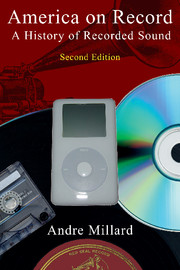Book contents
- Frontmatter
- Dedication
- Contents
- Preface to the second edition
- Preface to the first edition
- Introduction
- Part One The acoustic era
- 1 The inventors
- 2 A phonograph in every home
- 3 The international industry of recorded sound
- 4 The music
- 5 Recorded sound in the Jazz Age
- Part Two The electrical era
- Part Three The digital era
- Abbreviations used in the notes
- Notes
- Select discography
- Select bibliography
- Subject index
- Recordings index
- Motion picture index
5 - Recorded sound in the Jazz Age
from Part One - The acoustic era
Published online by Cambridge University Press: 05 February 2015
- Frontmatter
- Dedication
- Contents
- Preface to the second edition
- Preface to the first edition
- Introduction
- Part One The acoustic era
- 1 The inventors
- 2 A phonograph in every home
- 3 The international industry of recorded sound
- 4 The music
- 5 Recorded sound in the Jazz Age
- Part Two The electrical era
- Part Three The digital era
- Abbreviations used in the notes
- Notes
- Select discography
- Select bibliography
- Subject index
- Recordings index
- Motion picture index
Summary
The 1920s will always be remembered as the decade of prohibition, unrestrained hedonism, and the wild excesses of its “flaming” youth. There were radical changes in social behavior and in the way young people looked, dressed, and acted. Jazz reflected the lifestyle and aspirations of this affluent group, who had found “a native American music as traditionally wild, happy, disenchanted, and unfettered as it had become fashionable for them to think they had become.” Jazz expressed this reckless exuberance so well that the name given to the 1920s by F. Scott Fitzgerald has remained ever since.
Despite its image of wild abandon, jazz was a carefully crafted music that was created and promoted by the industry of recorded sound. It was another stage in the process of adapting African American music for popular consumption: a process that had begun with the coon song and was to continue through rock ‘n’ roll to rap. The single most important cultural accomplishment of the industry of recorded sound in the twentieth century was to make the music of black Americans the popular music of the world.
At each stage of this process, the cultural identity of African Americans was systematically removed from the music, making the final recording a commercial product which could conform to the values of a white society. The coon song came from the minstrel shows that supposedly represented “genuine darky life in the South” but which were the work of white performers in grease paint or burnt cork. A small number of black touring troupes were organized and controlled by whites. Although inspired by the African American culture of the slave plantation, the minstrel shows were a travesty of slave music and dance arranged for white audiences.
The same could be said for the coon songs on record. One only has to consider the titles of the most popular recordings to see this.
- Type
- Chapter
- Information
- America on RecordA History of Recorded Sound, pp. 96 - 112Publisher: Cambridge University PressPrint publication year: 2005



